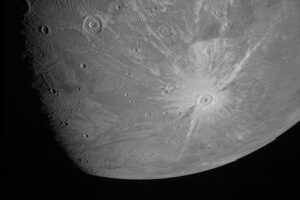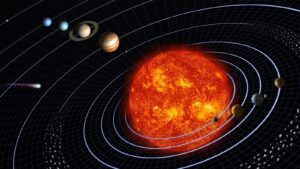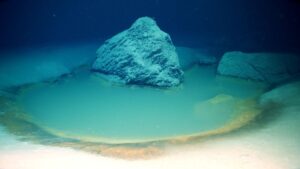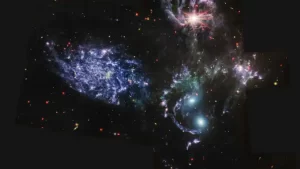
On July 12, NASA revealed the first spectacular picture of Cosmos captured by James Webb Space Telescope (JWST), the largest optical space telescope to be built. Launched on December 25, 2021, on the Ariane 5 rocket from Kourou, France Guyana, and in January 2022, arrived at his home in space, L2 (closest to the five lagrange points in which gravitational pulls from the Sun and Earth precisely were the same as The centripetal force needed for the telescope to move with them).
NASA developed JWST in collaboration with European and Canadian space agents. This is designed primarily to carry out astronomy in infrared. The main mirror consists of 18 hexagonal mirror segments made from gold -plated beryllium, which effectively provides a mirror with a diameter of 6.5 meters. JWST has a light collection area of about 25 square m, about six times the hubble, its predecessor. High infrared resolution and sensitivity allows it to draw objects too old, far, or fainted to be seen by Hubble. JWST will allow observation of the first stars and the formation of the first galaxy and detailed atmospheric characterization of the potentially livable exoplanet. Each first picture released contains objects that were previously not visible starting from the dying stars spewing gas to the dancing galaxy quintet.
Cosmic cliffs in Carina Nebula. The picture “Cosmic Cliffs”, which looks like a 3D mountain image, is a testimony of the telescope ability to peek through dust and cosmic gas to express nurseries and individual stars. Cosmic landscape of mountains-some of the seven years of light and valleys that are seen in this picture are snapshots from the nearest nursery edge called NGC3324 in the northwest corner of Carina Nebula, which is located on Milky Way in Milky Way in Milky about 7,600 years from earth from Earth . “Mountains” studded with a sparkling young star that was imaged in infrared. Nebula is believed to contain gas supply and dust that seems endless from which new born stars and planets. “Today, for the first time, we see new stars that were previously fully hidden from our view,” said Amber Strughn, Deputy Scientist of the JWST project. Large areas appear carved from nebula. This is caused by intense ultraviolet radiation and star winds from young stars that are very massive, hot, which are located in the middle of the bubble above the area shown in this picture. “Steam” which seems to rise from the “mountain” is actually hot, ionized gas and hot dust flowing from nebula due to endless radiation. Jet Protostellar came out of some of these young stars. The youngest source appears as a red point in a dark and dusty area of clouds. Dusty young stars and disks, planets forming brightly shining in the middle of the infrared, look pink and red. | Photo Credit: NASA, ESA, CSA & Space Telescope Science Institute (STSCI)
The last “performance” is dying with good details. JWST has revealed a new detail from the South Nebula Ring, a Nebula Planet that was catalked as NGC 3132 which is 2,500 light years away. This is a complex system in which two stars are locked in a tight orbit. Observing the nebula in the middle infrared wavelength has shown a second star in the middle in more detail. Nebula Planet – Gas and dust clouds released by dying stars – are there for thousands of years. During this period, the dimuping star in the middle of this scene is known to send a gas and dust ring. In the picture to the left of the stars, and their layer of light, stands out. The picture on the right, shows for the first time that the second star is surrounded by dust. Brighter stars are in the early stages of the evolution of their stars, and when stars continue to orbit with each other, they “stirred pots” gas and dust, creating the cosmic image of asymmetrical shells. Each shell represents an episode in which a faster star loses part of its mass. The widest gas shell to the outside area is released before. Those closest to Bintang are the latest. | Photo Credit: NASA, ESA, CSA & Space Telescope Science Institute (STSCI)
Stephan quinteen. The term Kuintet Stephan is best known from the formation of angels in the 1946 classic film “It’s a Wonderful Life”, but this term is actually borrowed from astronomy. This refers to the visual grouping of five galaxies and named Edouard Stephan, a French astronomer who discovered it in 1877. The JWST image showed a quintet in a new light. This is the biggest picture of the telescope to date, covering a visual plane which is about one fifth of the diameter of the moon. The picture shows the tail of the gas and dust and stars pulled from several galaxies due to gravitational interaction. Large shock waves caused as one of the galaxies, NGC 7318B, destroyed through the cluster seen in extraordinary details. Only four of the truly close quinteses and are involved in cosmic dances. The fifth and left galaxy, called NGC 7320, is around 40 million light years from Earth, while the other is around 290 million light years. The closeness of the quintet and the tightness of the group gives astronomers of the ring view of the merger and interaction between galaxies, which is an important part of their evolution. The top galaxy in the group, NGC 7319, accommodates the core of the active galaxy, supermasi -black holes 24 million times the mass of the sun. This actively attracts material and releases light energy equivalent to 40 billion sun. | Photo Credit: NASA, ESA, CSA & Space Telescope Science Institute (STSCI)










